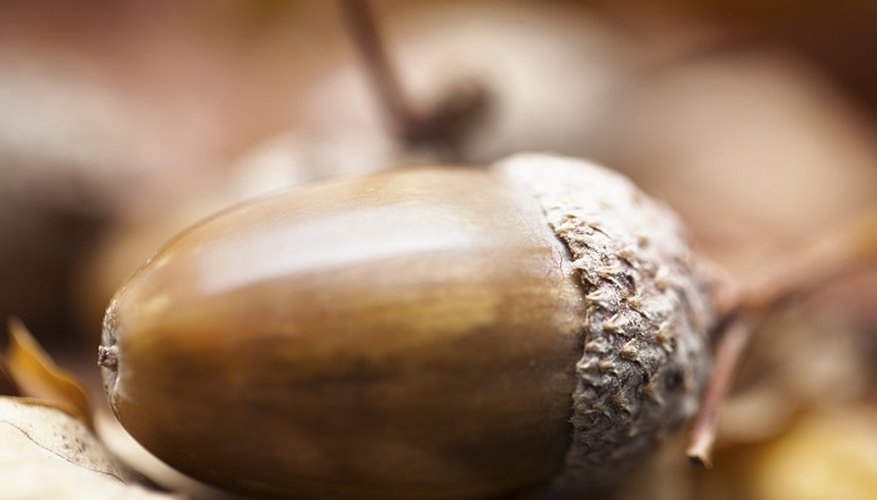As is the case with all trees, the mighty oak begins as a tiny seed. In order for the tree to grow and the life cycle to complete itself, the oak requires sufficient space, water to carry root-borne nutrients from suitably fertile soil and adequate sunlight to trigger the life-sustaining process of photosynthesis. Insect infestation, disease, scavenging animals and adverse weather conditions can prematurely end the life cycle at any stage. An oak can live from 500 to 1,000 years.
Seed
Adult oak trees produce seed-protecting structures called cupules. The cupule, better known as an acorn, contains the first stage of the life cycle -- the seed. Depending on the species, the oak seed requires six to 18 months to reach maturity. Mature acorns fall from the tree and are dispersed by scavenging animals, such as squirrels. Acorns not consumed and left 27 to 30 metres (25 to 30 yards) away from the parent tree have the best chance of germinating and sending a tap root into the soil.
- Adult oak trees produce seed-protecting structures called cupules.
- Acorns not consumed and left 27 to 30 metres (25 to 30 yards) away from the parent tree have the best chance of germinating and sending a tap root into the soil.
Seedling, sapling, pole
Once a shoot appears above the ground, the oak seed has entered the seedling stage. The seedling grows slowly -- about 30.5 to 43 cm (12 to 17 inches) per year. Once a seedling reaches a height of 1 metre (39 inches) with a trunk diameter of around 7.5 cm (3 inches), the oak enters the sapling stage. A sapling that survives beyond this trunk thickness and lives to reach 30.5 cm (12 inches) across has become a pole. The pole continues its slow growth until the tree reaches maturity.
- Once a shoot appears above the ground, the oak seed has entered the seedling stage.
- A sapling that survives beyond this trunk thickness and lives to reach 30.5 cm (12 inches) across has become a pole.
Maturity
A mature tree measures more than 30.5 cm (12 inches) in diameter and has begun its reproductive stage. Acorn production signals oak tree maturity. At this stage the oak will be approximately 10.5 metres (35 feet) tall and approximately 20 years old. An oak tree will continue to produce acorns well into old age. Production peaks when the tree is 70 to 80 years of age, and begins to decline as the growth of the tree slows.
- A mature tree measures more than 30.5 cm (12 inches) in diameter and has begun its reproductive stage.
- At this stage the oak will be approximately 10.5 metres (35 feet) tall and approximately 20 years old.
Old Tree, over maturity, snag and debris
An old oak continues to grow, but at a declining rate. Acorn production also decreases as the tree enters over maturity. At this stage, parts of the tree begin to die back and areas of decay become evident. A completely dead tree, or snag, continues to stand upright on the forest floor, but exhibits no new growth. Once a snag falls to the ground, it becomes debris. Decomposition continues to occur until the oak is returned to the soil from which it came.
- An old oak continues to grow, but at a declining rate.
- A completely dead tree, or snag, continues to stand upright on the forest floor, but exhibits no new growth.
